Luck & Chance & Good & Bad
One writer’s view of St. John, 11 weeks after Hurricane Irma.
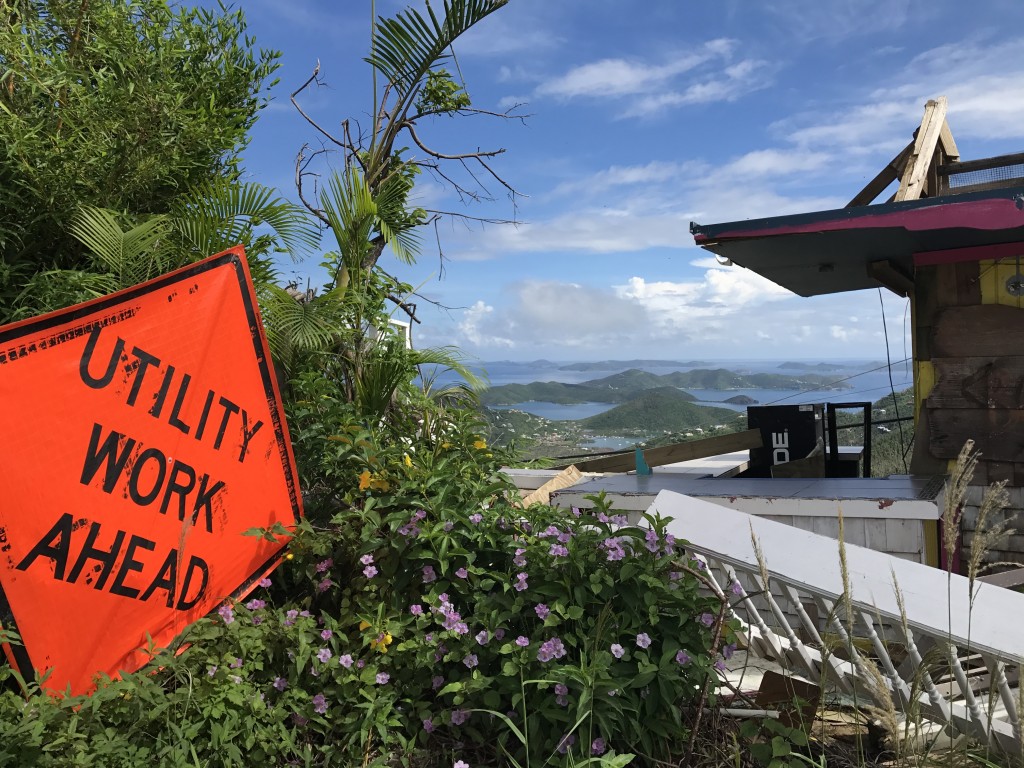
At first it all seems almost normal. After two months of waiting, of searching for clues, of seeing the pictures of the devastation and the signs of renewal, of failing to have an actual phone call with anyone on island, of trying to read between the lines of the updates they manage to post on Facebook, you just want to see for yourself. So after two friends say they have a place for you to stay, you book a flight, and that’s normal, and you discover you can even rent a car online.
Most travelers had to be up early to make that 10:35 flight connection out of Miami, but I’m surprised that so many have their window shades pulled down as we approach Puerto Rico and St. Thomas. Don’t they want to see? I can’t wait for my first glimpse, to see something with my own eyes, but when I do, it still doesn’t tell me much. I see green and blue. Normal.
You disembark from the back of the plane and feel that first blast of tropical heat. A few letters are blown off the sign at Cyril E. King, but the airport is functioning. You walk past construction, sure, but the Caribbean music is playing and the free rum punch is there if you want it, and the bags are already coming off the conveyor belt, and the taxis are lined up and waiting, and before you know it, you’re on your way to the Red Hook ferry dock and, again, it’s almost normal. You can tell there’s been a storm, you see damage around St. Thomas, but there’s traffic, and people, and business being conducted, or so it seems, or maybe you’re just distracted by the young woman sitting next to you in the cab who also is returning for the first time (you heard her tell the cab driver) but spends the entire trip staring at her phone, apparently shopping for a leather jacket. Doesn’t she want to look around?
The sun is shining and I make the 4 o’clock boat and sitting inside I see some people I know and it’s the first time I see what I will later hear called “the look.” I don’t know whether to describe it as vacant, or slightly wild-eyed, or maybe just beyond exhausted. It is not quite approaching defeated, but it is definitely not normal. This couple were on island for both Hurricane Irma on September 6 and Hurricane Maria two weeks later and are just returning from what should have been a much-needed break up north, but it was too short, and too stressful, trying to cut through the red tape of shipping down the things they need to rebuild their home, trying to figure out what’s next since he lost his job and his business.
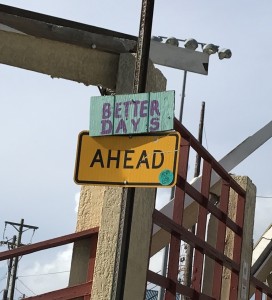
The mood shifts when we dock. St. John. You almost didn’t quite believe it was still here. Fresh-faced, in-charge relief workers greet the boat. Men and women in their clean shirts labeled Bloomberg or Johns Hopkins are off-loading boxes and bags, tangible evidence that Things Are Happening.
My friend who meets me at the Cruz Bay dock is one of these “Do-ers,” one of the people making things happen. She works for the St. John Community Foundation, her job to take care of the needs of St. Johnians even before there were two Category Five hurricanes. She has a lot of company these days. In her tiny office—and all over the island—in the days that follow, I will see people from the Coast Guard and the National Park Service and the Army Corps of Engineers, from Kenny Chesney’s Love for Love City Foundation and Bloomberg Philanthropies and Love City Strong, and from all those acronyms that spell disaster relief and recovery: VITEMA, FEMA, VOAD, DIRT, and the BBC (more on them later). There are helpers and do-ers everywhere.
We go to Mongoose for a Painkiller. (Almost normal. Normal would be the Beach Bar, but all of Wharfside Village is shuttered and fenced off—save for Paul’s shiny and stocked Island Cork—a handful of beached boats still blocking the entire front of the complex.) My friend tells me about the successes and setbacks of her day—the hurricane rhumba, another friend calls it. One step forward, six steps back. She is relentlessly positive. We have dinner at Sun Dog where the lights are on, the place is buzzing, and people are upbeat. It’s a good night because Ted cooks on Tuesdays. Ted is one of the best chefs on the island, I am told. The dry rub mahi is delicious.
The house where my friend is staying fared well in the storms. The owners, off-island, apparently had the money—and the island wherewithal—to get things repaired, scrubbed, done. The house is clean and comfortable. There’s no power, but she has cool solar lights, plus a big generator. She turns the generator on long enough to settle in, take a hot shower, and flush the toilets before retiring for the night. The breeze is so strong on this hill overlooking Great Cruz and the Westin, I have to close a window. The stars are out. The tree frogs are singing. Normal.
***
The imposing West Indian man in the car rental place is talking about the rain. Everyone has been complaining about the rain but “the rain made everything green,” he says. “Maybe God knows what he’s doing. Maybe the island needed a cleansing.”
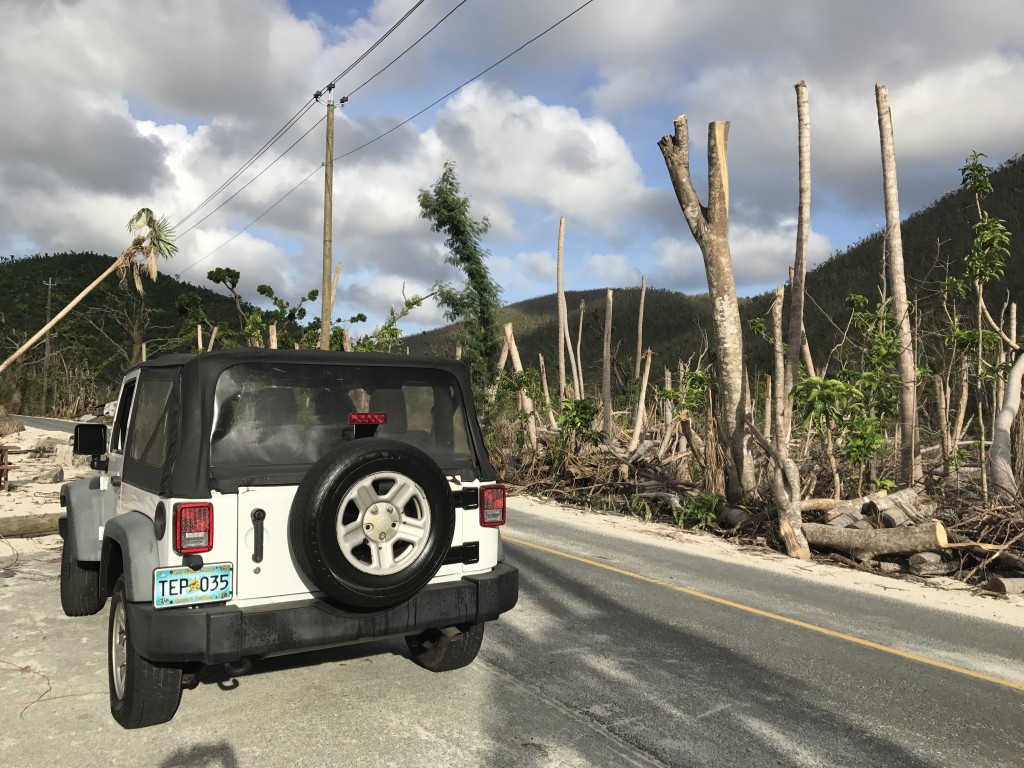
The island is so green—and has been for about two weeks, I’m told—a stark contrast to those early days when all of St. John looked desolate, a barren, scorched landscape, not a leaf to be found. When home looked so strange and foreign, a National Park ranger (St. John is two-thirds National Park) who has lived here for years got lost trying to get to work. That green and the bursts of red and orange and purple from the flamboyant trees and the bougainvillea, and, always, the blue of the water, make for a stunning—and incongruous—frame for the scenes of obliteration you see on that first drive around: A pile of rubble where Chateau Bordeaux used to be. Decapitated palms at beloved Maho beach. The Shipwreck restaurant smashed to smithereens. We’ve all seen the pictures, but it doesn’t really prepare you. Downed power and telephone lines as well as piles of rock and debris litter North Shore Road and Centerline, which are just fine in parts, and cratered with muddy potholes in others. The road is single track in some places, forcing people to slow down or even stop in some places and wait for oncoming traffic to pass. Fewer people and, I suppose, fewer working cars mean less traffic, but I swear, it still seems there’s almost always someone riding up my ass. (Normal.) Heaps of wood and metal that used to be somebody’s home cling to the hillsides. So many trees were toppled or denuded, there are now views of the sea where they used to be none. It’s hard to take it all in, harder still when you’re driving, but a few glances around show the randomness of the destruction: a house intact next door to a house blown to bits, a FEMA blue roof covering what’s left. Blue used to be just the color of the water, but now it’s a color of the land, too.
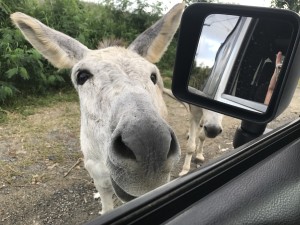
On my very first drive I see lots of wildlife, and that’s encouraging: donkeys, mongoose (mongeese? I never know the plural…), goats, cows, pigs. Deer, pelicans, and a bananaquit will soon get added to the list.
The friend I stay with in Coral Bay has not fared as well as my friend in Cruz Bay. Her property is in ruins, her personal possessions and tools of her restaurant business soaked by Maria after Irma took her roof, but she is also—on this day, at least—relentlessly positive, her boisterous laugh buoying the people around her, her bear hugs consoling another young woman who starts sobbing when we see her in the grocery store and ask how she is.
We stop at Connections, where people get their mail, to see what that day’s deliveries have brought in. My friend can’t get the screws she needs to put her roof on, but Jen, who runs Connections, has to make a trash run every day to get rid of all the catalogs taking up precious space in her cramped office. Even in a hurricane, the junk mail gets delivered. A care package from Boston contains work boots and clean socks—a big hit. A bag of trail mix is roundly rejected. Nobody wants to see another bag of trail mix. I make a feeble attempt to defend the poor sap who sent it. (I’ve sent a few boxes of it myself.) People want to help and they don’t know what to send, I offer. Some well-meaning church sent boxes of blankets and sweaters. Not much use in a place where it’s 80 degrees—at night. Medical supplies not from an official source have to be thrown away. Getting unwanted stuff off the island is as challenging as getting the needed stuff on. There’s a reason relief organizations ask for cash.
I wanted to bring as much as possible with me when I flew down, but every single person I was able to communicate with said they didn’t need anything. The truth is that many need almost everything. This one needs a roof. That one needs furniture. Let’s not even talk about the jobs just yet. The final item in the care package is a Kenny Chesney Christmas CD, from the $5 bargain bin. My friend gives it a big thumbs down. Jen snatches it up. Nobody’s allowed to say anything bad about Kenny, who’s funneled millions to the island so far. It’s because of him that Skinny Legs, the famous burger shack next door, now has a new roof, and a real one at that, not just a bunch of old sails.
We need the four-wheel drive to get through the muck that counts as a road to my friend’s house. She gives me a tour of the damage, of the mold, of the tiny closet where she and two friends huddled, cross-legged during Irma, water rising up to their waists. I brought her new sheets and pillows, and I’m embarrassed when she puts them on the bed where I’ll be sleeping. She shows me how to pull buckets of water up from the cistern to flush the toilet. She points out all the hazards while it’s still light: the open hole in the floor where they access the cistern; the stair railing on the left that’s about to give way; the network of extension cords snaking across the floors to position as many fans as possible toward the beds, the only relief from the bugs. From her front porch she gives me an assessment of her neighbors, all of whom, she thinks, are worse off than she is: the Haitians next door, living under a tarp; the family across the valley whose girls shrieked with joy every time they plucked something salvageable from the wreckage that used to be the second floor of their home; the couple whose home survived, but their business is gone and he suffered a stroke. She, too, has a view of the water where there used to be none. Maybe two dozen boats are floating in Coral Bay harbor, which seems sort of normal, except you realize most are sailboats and are supposed to have masts. Dozens more boats lie in jumbles on the shoreline, or splintered on the rocks.
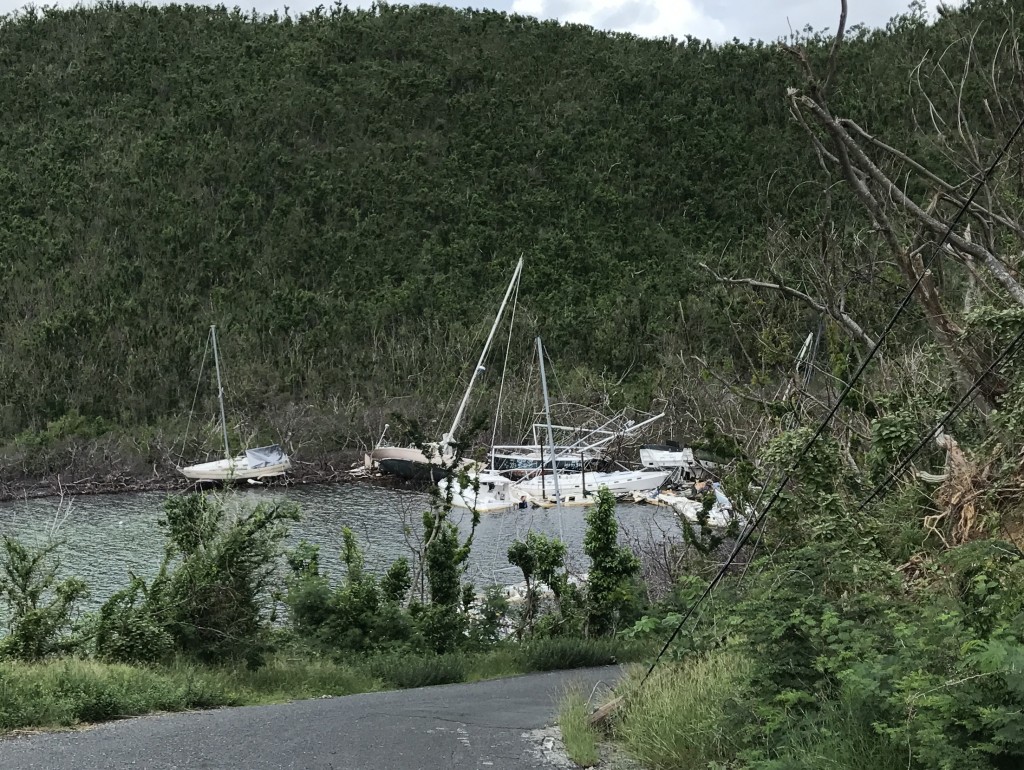
My friend, who I know is one of the best chefs on the island, cooks dinner for half a dozen people—pasta with fresh vegetables, which have only recently begun appearing in the grocery stores. The meal is delicious. Halfway through, she mentions she had to pick weevils out of the pasta. There’s a brief pause in conversation, but nobody stops eating.
***
At 7:30 in the morning, Coral Bay is a hub of activity. A line of cars backs up towards the Disaster Recovery Center, across from the firehouse. You hear chainsaws and construction sounds. A fleet of BBC trucks hits the road. BBC Electrical Services is an electric utility contractor based in Joplin, MO and contracted to repair the power lines. Their linemen—uber-friendly, exuding competence, are working all over the island, seven days a week, the new heroes of St. John. The cavalry, someone called them.
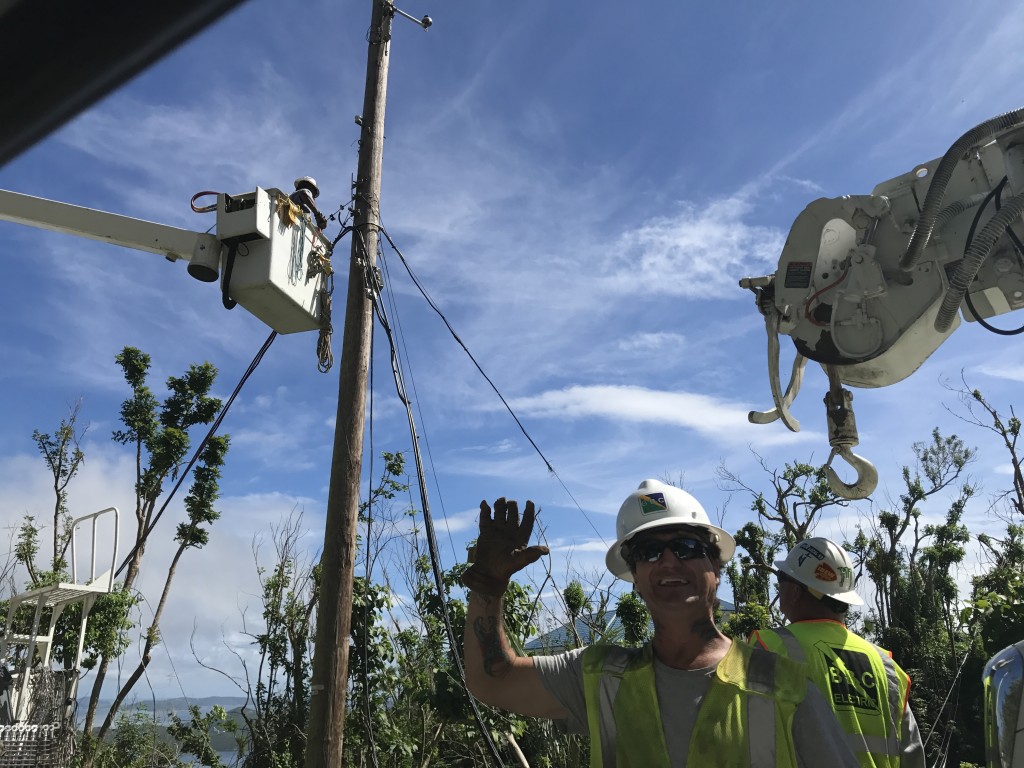
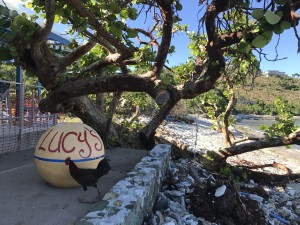
Amidst the obvious progress are other signs of hope. Three National Park beaches are officially open, and beckoning. One of Miss Lucy’s sea grapes is flourishing on the beach in front of the closed restaurant. Delicate pink flowers bloom across the top of the fence around the Coral Bay ball field, which is currently being used as a trash transfer station. A tamarind tree, keeled over and uprooted, sprouts tiny shoots of green. While it’s hard to see new growth as anything but positive, one friend confessed to wanting to send a big Fuck You to Mother Nature for bouncing back when so many others were not quite ready.
We take a drive out to East End. It’s one of those clear days when you get a spectacular view of the BVIs. From a distance they exude normalcy. They are velvet green, and the sky and water are Caribbean blue, and then someone points out that Thanksgiving is just days away and there is not a single boat in Sir Francis Drake Channel. Not one. Not normal.
My friend checks on other friends whose property she has not seen. One structure is covered with a blue tarp. Another is open to the sky. Someone is living in a tent. A big stone house looks untouched, a fortress. I see more people with “the look.” “I can tell you weren’t here for it,” one weary woman says to me. “You’re too clean.”
“That hurricane was luck and chance and good and bad,” says a native islander, another resident who counts himself among the blessed, even though he lost his roof and his car, and his home was wet for weeks and weeks, and both he and his wife, he says, are suffering from “hurricane brain.”
I watch people greet each other: “How are you?” “I’m good. How about you?” “Good. We’re good.” In some cases, I know what “good” means for one person who is speaking, and I can tell you it’s not what a lesser person would call “good.” I can only imagine how the other person in this conversation is defining “good.”
Sometimes I am the greeter. “How are you?” I will ask, a vague, anodyne question because at first I’m not quite sure what to ask, if they want to talk. “Good,” they will answer, and I don’t have to ask any questions because then we will sit down and an hour and a half later, they will still be talking. About the 200-plus mile-per-hour wind gusts. About the closet where they hid during Irma’s screaming eye. About the bombed out aftermath. About the people who came to help. The flotillas from St. Croix and Puerto Rico. The helicopters dropping food. The first responders. The people who went door to door. The Red Cross working with the functioning restaurants to serve hot meals every day. The things they lost. They things they salvaged.
Make sure you write about the bugs, someone says. They came in waves. The Jack Spaniard wasps, the mosquitoes, the no-see-ums, some big green things. Write about the hurricane diet. Everyone’s lost at least 10 pounds; some of the men, 30. Be sure to talk to X, her shirt got blown off during Irma. Talk to Y, he can’t even find his boat. Write about the local people. What are the taxi drivers doing? How are the kids? One Coral Bay mother who evacuated her family from the boat where they lived told me her little girl wanted desperately to take a favorite doughnut pillow with her but there was no room in the dinghy. She soldiered through the storm, a 5-year-old trooper, who didn’t cry until a few days later when, asking when they’d go back to the boat to get her pillow, finally understood they were never going back. In Cruz Bay, a dance instructor says her dream is to organize a free trip to Disneyworld for some of her young students. She asked them to write down why they need a break: “I’m tired of doing my homework by flashlight.” “I’m being skinned by mosquitos.” “I’m afraid of the dark.”
Some people have had no breaks and none are in sight. Some have breaks coming up. One hurricane survivor, who just returned from a break, told me he was lucky to get up north to “decompose” for a couple weeks. I wrote “decompress” in my notes, but thought later that maybe he had it right.
On the Sunday before Thanksgiving there was (more) torrential rain. Restaurants closed, plans were cancelled, roads were flooded, everybody stayed home. It was damp and depressing. By some accounts, there have been 40 inches of rain since the hurricanes. In the two days after the rain, when the skies were clear and people were out and about again, three different friends mentioned wanting to learn more about PTSD. Not that they were worried about themselves, mind you, but they thought “some people” might be suffering from it. Any heavy rain or strong gust of wind these days seems capable of triggering fear in someone. Almost every female friend I have on island has cried in the week I’ve been here, and I’ve seen more than one grown man on the verge of very public tears. People are smiling, and people are strong, and they are optimistic, and it is just not possible that they are not very, very tired. The DIRT (Disaster Immediate Response Team) folks checking up on people have a list of assessment questions. One of them is: Do you feel you need emotional support? No, come the replies. I need a roof. I need a job. It’s suggested that maybe the wording of the questionnaire should be changed: Do you feel like punching someone in the nose? We can guess the answer to that one.
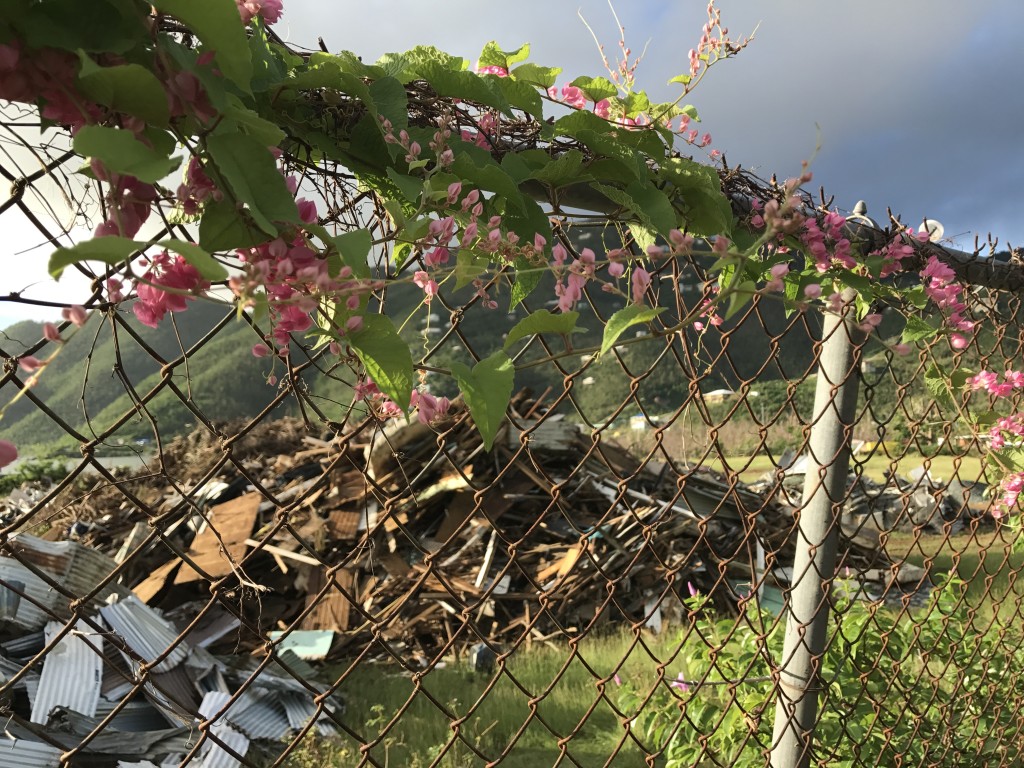
The big question, of course, is when will the island be ready for tourists, and on this opinions are fierce and disparate. Those who fell on the good side of luck and chance are naturally eager for business to get going again, as are those less fortunate who also depend on tourism for their livelihoods and, moreover, their futures on St. John. Others see the weakened infrastructure and strained ability to serve the local people and say the island is not close to ready. One person squarely in the not-ready camp reminds me that the clinic has been condemned and there is scant access to health services. There is little room for error. I offer no opinion on this as I know only the tiniest fraction of what is going on here, but I’ll make one observation as a witness who is neither local, nor a first timer. It seems to me that St. John personified—the island and its infrastructure—is telling the same story as its people: Beautiful, resilient, optimistic, on the whole; and yet, in certain places and times, still with “the look” that reminds you it has endured something severely traumatic, is quite fragile, and may be harboring issues that are yet to be revealed.
Meanwhile, by Thanksgiving, the weather was better. The sun was shining. In the face of immeasurable loss, there is much to be thankful for. There was a free Thanksgiving celebration in Cruz Bay park for residents and responders, sponsored by the St. John Community Foundation and the Rotary Club. Long-haired Ken hosted his annual Thankspigging celebration (the 17th) under the new roof at Skinny’s. This year’s theme was Irma la Douche. This weekend the Coral Bay Yacht Club holds its annual regatta. This year’s theme: the Not a Lotta Yachta Regatta. One thing this community did not lose was its sense of humor.

0 Comments on “Luck & Chance & Good & Bad”